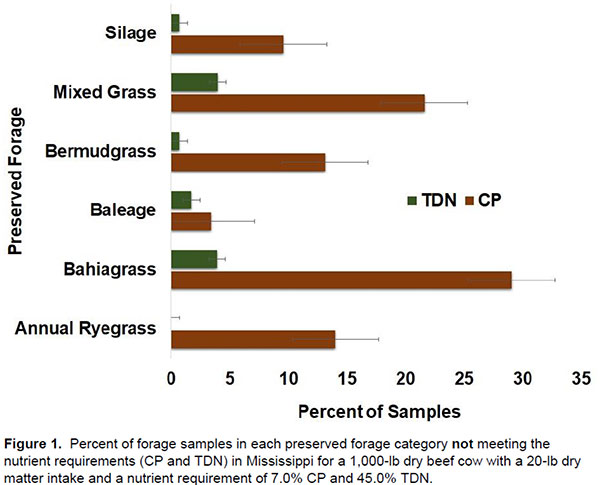
It’s not that testing forages shouldn’t always be a member of the “must do” category; it just pushes higher up the list as the upcoming winter approaches.
Supplemental feeding is going to be more expensive this winter with higher prices for both protein and energy. Mistakes made on the amount of supplement fed will have a greater impact on the bottom line in the current feed-price environment.
With higher supplement costs comes the fact that hay quality is more variable this year because weather was more variable or, in some cases, extreme. “Hay is hay” simply won’t cut it on most farms.
“One of the advantages of a hay testing program is to determine the lowest ration cost possible to maintain the expected animal performance,” says Rocky Lemus, extension forage specialist with Mississippi State University.
To demonstrate how different forage types can vary in their ability to meet beef cow nutrient demands, Lemus provided the following two graphs in a recent issue of his Forage News newsletter. Note the wide variation that is seen in the sampled forage types and species for meeting the nutrient requirements of either a dry cow (Figure 1) or a pregnant cow (Figure 2) with different nutritional needs.


Get a good sample
An accurate hay analysis hinges on obtaining a representative sample.
“A composite sample should always be collected from the entire lot,” Lemus notes. “A lot means hay that was harvested and stored under the same conditions.”
When collecting a hay sample, Lemus recommends taking subsamples from about 10% of the total bales by coring at 18 to 24 inches into the bale. Collect samples at least two weeks postbaling. The best time to sample is close to feeding time, if this is feasible. In the case of baleage, collect samples at least 35 days postwrapping to ensure proper fermentation has taken place.
Once a composite hay sample is obtained, send it to a lab that is certified by the National Forage Testing Association. Be certain to provide as much information as possible so that the correct analysis can be run.
Lemus notes that data obtained from a hay analysis can be input into the Mississippi State Hay Calculator to determine deficiencies in nutritive value.
“Not all hay is created equal, and there is a significant variation in nutrient content within a particular type of forage species based on maturity, fertilization, temperature, and conditions at harvesting and baling,” Lemus asserts. “When using hay produced on the farm or purchasing hay, develop a feeding program based on individual livestock requirements. Proper ration balancing begins with hay testing so that you can know what is being fed.”

